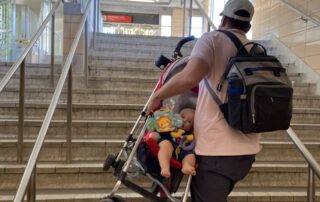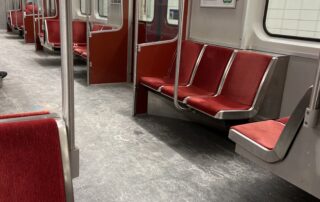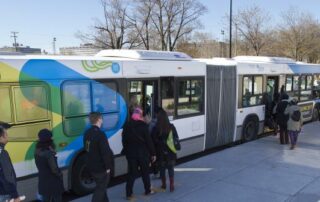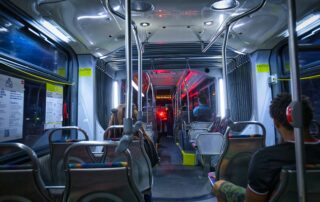Latest Publications
Read the latest publications from the Transport Team here.
Latest Public Transit Electrification Research
FACILITATING TRANSIT ELECTRIFICATION: Empirical analysis of battery-electric bus transit operations in Portland, OR, USA PROJECT OVERVIEW Technological improvements and a significant reduction in battery production costs have made battery-electric buses (BEBs) a commercially viable alternative to diesel buses. However, there is little information available on how these buses perform based on actual operational data. In this study we used AVL/APC records of electric, diesel, and hybrid buses operated by TriMet in Portland, OR, USA covering the period of September 5, 2021, to June 6, 2022, to perform the following analyses: We estimated a [...]
Understanding and Responding to Women’s Transit Needs
PROJECT DESCRIPTION The historical practices of transportation planning are known to be gender-neutral. Identifying the motives behind women's travel behaviour works to inform equitable data collection methods, transportation planning, and public transit policy. However, systematic gender inclusion procedures, spanning from the hiring of professionals to the design or planning of systems and equipment, are yet to be widely identified or highlighted within the Canadian context. This knowledge mobilization study, which was carried out in partnership with researchers at the University of Alberta, Polytechnique Montréal and transit planning industry advisors from Leading Mobility Consulting, revealed [...]
Effects of the COVID-19 Pandemic on Public Transit in Vancouver
From Riding to Driving: the Effects of the COVID-19 Pandemic on Public Transit in Metro Vancouver This study analyzed a panel-based dataset to understand the effect of COVID-19 on transport behavior in Metro Vancouver, Canada, between December 2020 and May 2021. Findings from the sample indicate a decline in transit users compared to pre-pandemic levels and an increase in car use. On the other hand, we saw a shift to a more positive perception of transit in May 2021, while also capturing an increase in perceived levels of crowding. The study underscores the necessity for transit agencies to [...]
Integrating Public Transit and Shared Micromobility Payments
Paper Abstract This study explores how shared micromobility services can integrate with public transit through equitable payment structures to address first and last mile issues for light rail transit riders in Seattle, WA, and increase accessibility for low-income households. Seattle has recently permitted shared micromobility services such as e-scooter companies to begin operating alongside existing bikesharing services in the city. However, equity concerns have arisen as the users of bikeshare have been disproportionately white, affluent, and well-educated. To address these concerns, efforts have been made to reduce barriers to access and make these services more equitable to encourage [...]
Elevating access: Comparing accessibility to jobs by public transport for individuals with and without a physical disability
Photo by Damir Kopezhanov on Unsplash Equal access to opportunities has emerged in public transport planning as a social objective that many transport agencies are trying to achieve. Yet in practice, not all public transport agencies are currently providing urban residents with comparable levels of service due to physical barriers in the public transport network that can significantly hinder the ability of individuals with physical disabilities to access opportunities. In countries without a strong federal accessibility act and/or with major financial constraints, some public transport agencies fall behind in applying universal access design principles, making it even harder [...]
Get on board: Assessing an all-door boarding pilot project in Montreal, Canada
Photo from www.stm.info Abstract Transit agencies often focus on developing strategies aimed at reducing travel time to increase passengers’ satisfaction. One strategy used by transit agencies to reduce passenger activity time, and accordingly travel times, is the implementation of all-door boarding – a service allowing transit users to board and alight vehicles through any door. The present study uses data collected in Montreal, Canada, to assess the impacts of an all-door boarding pilot project from two points of view: (1) operationally through passenger activity time, and (2) by assessing passenger satisfaction. Operationally, the results reveal that when compared [...]
When I’m 64 – Assessing Generational Differences in Public Transit Use of Seniors in Montreal, Quebec, Canada
Photo by Launde Morel on Unsplash Abstract The growth rate of adults older than 65 in Canada is increasing more rapidly than the population as a whole. This increase is reflective of the aging baby boomer population. That population is known to have a strong attachment to automobiles, which might be reflected in their travel behavior as they move toward different stages in their older life. The purpose of this paper is to contribute to the understanding of the travel behavior, mainly public transit usage, of Canada’s older population relative to younger cohorts. A pseudocohort analysis was conducted [...]
Identifying the Bias Evaluating Effectiveness of Automatic Data Collection Methods in Estimating Details of Bus Dwell Time
Photo by Andrew Coop on Unsplash Abstract Data from automated vehicle location (AVL) systems, automatic passenger counter (APC) systems, and fare box payments have been heavily used to generate dwell time models with the goal of recommending improvements in efficiency and reliability of bus transit systems. However, automatic data collection methods may result in a loss of detail with regard to the dynamics of passenger activity, which may bias the estimates associated with dwell or passenger activity time. The purpose of this study is to understand better any biases that might exist from using data from AVL–APC [...]
Evaluating the relationship between socially (dis)advantaged neighbourhoods and customer satisfaction of bus service in London, U.K.
Photo by Lawless Capture on Unsplash Abstract Affordable and efficient urban public transport is important for the development of a sustainable urban environment. Making sure public transport users are satisfied with the service is a goal many public transport agencies are trying to achieve. Customer satisfaction surveys are often used to monitor customer perceptions of service quality and to determine the relative influence of service attributes on a customer’s overall assessment of the service. This study presents a new method to spatially evaluate customer satisfaction survey data through examining satisfaction with bus service across neighbourhoods of varying levels [...]
Planning a High-frequency Transfer-based Bus Network: How Do We Get There?
Photo by Karen Lau on Unsplash Abstract As cities have grown more dispersed and auto-oriented, demand for travel has become increasingly difficult to meet via public transit. Delivering high-quality bus service in this challenging environment has recently brought attention to bus network design. Commonly, bus networks are designed with a door-to-door approach, which often entails a circuitous route design leading to slow and infrequent service, especially in the suburbs. Alternatively, high-frequency transfer based networks have been promoted as the optimal network design for ridership, experience and operational efficiency. For cities wishing to adopt such a network design, there [...]
Assessing operation and customer perception characteristics of high frequency local and limited-stop bus service in Vancouver, Canada
Photo by Dhruv on Unsplash Abstract Public transport agencies implement different strategies aimed at improving transit service operation and to improve satisfaction among its riders. One service strategy employed by transit agencies is the introduction of a limited-stop bus service that runs parallel to a heavily used route to decrease travel times for existing riders and to reduce pressure from the local route. Using bus operations data obtained from automatic vehicle location (AVL) and automatic passenger counter (APC) systems and customer satisfaction data collected in Vancouver, Canada, the present study evaluates levels of satisfaction among users of the [...]
Transferring Matters: Analysis of the Influence of Transfers on Trip Satisfaction
Abstract Conventional wisdom in public transport planning suggests that transfers should be minimized because of the negative perceptions associated with them. However, little is known about how transferring affects overall satisfaction levels. This study aims to answer the following three research questions: (1) Are people that require transfers on their daily commute less satisfied with their trips compared with their non-transferring counterparts? (2) How many transfers appear to be too many transfers to remain satisfied with a trip? (3) Do mode-specific transfers have different impacts on overall satisfaction levels? Using data from a 2017/18 commuting survey of students, faculty, and [...]
Evaluating methods for measuring daily walking to public transport: Balancing accuracy and data availability
Abstract Background: Quantifying physical activity accumulated through daily commuting is challenging due to the scarcity of detailed data, especially for public transport trips. Using Montreal, Canada as a case study, this paper measures and compares an individual’s daily amount of walking to and from public transport in their regular commute to work using two datasets and two methods. Methods: The first method used urban level detailed origin-destination microdata. Distances walked to and from public transport stations were measured using trip details provided from the survey. The second method used open data including commuting flows obtained from census data. Public transport [...]
Invest in the ride: A 14 year longitudinal analysis of the determinants of public transport ridership in 25 North American cities
Abstract Public transport ridership has been steadily increasing since the early 2000s in many urban area in North America. However, many cities have more recently seen their transit ridership plateaued, if not decreased. This trend in transit ridership has produced a lot of discussion on which factors contributed the most to this new trend. While no recent study has been conducted on this matter, understanding the levers that can be used to sustain and/or increase transit ridership is essential. The aim of this study is, therefore, to explore the determinants of public transport ridership from 2002 to 2015 for 25 [...]












